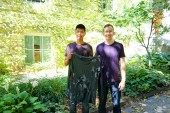
Unless you’ve been living under a rock, you know traditional print media is ensconced in a battle with an ever-growing army of amateur and professional digital publications. With publishing houses merging, downsizing, and even going under, the future of the printed book is in question. But its value as an educational and communicative tool, as cultural, historical, and artistic artifact, remains unchanged.
There’s no digital reading experience that can compare to holding a 350-year-old tome, the first – likely, only – edition of its kind, to leafing through a first edition of Jane Austen, or Twelfth Night, or reading through Margaret Atwood’s private papers and childhood work. All these items are sitting readily and freely accessible to the public at the University of Toronto’s Thomas Fisher Rare Book Library, an important cultural institution that many Torontonians know little about. It’s easy to see why. Stepping into the library for the first time a few weeks ago was not unlike stepping into a cathedral. Six levels of dimly lit shelving demand an awed silence, a reverence reserved for houses of worship. The balconied stacks, accessible only by librarians, house a fraction of the library’s 700,000 volumes, 90 per cent of which remain in the building’s basement. Standing in their presence is intimidating. It’s also exciting.
With a mission to “support the teaching and research at the University of Toronto,” the library’s collections are broad, with strong holdings in the history of science and medicine, 20th century philosophy, Canadiana, and literature. It’s a reader’s paradise. Books, manuscripts, ephemera, and visual items like a collection of 6000 historic Canadian beer labels or 1,100 items of gay pulp fiction wait to be explored. I met with Anne Dondertman, Director and Associate University Librarian for Special Collections, for an inside look at what we’ve been missing behind the Fisher’s turnstiles.
The Collection
Canadiana
Some of the library’s most interesting holdings include the literary papers of Canadian icons Margaret Atwood and Leonard Cohen. Atwood, who donates new material to the Fisher almost every year, has made available correspondence, first drafts, and unpublished materials. The collection includes her juvenilia, a selection of childhood works that demonstrate how accomplished and articulate a story teller Atwood was even at a very young age. The Leonard Cohen collection favours his early career, but also includes items that have more recently become available– including fan mail.
As for more ephemeral items, old Toronto maps and plans can be experienced first hand, including fire insurance plans going back hundreds of years and actual beer labels from across the country. The collection is “so comprehensive [that] if you look at it chronologically it tells you a lot about the history of graphic design [and] marketing,” said Dondertman. A significant portion of the collection is available online, rights restriction free.
Literary
For readers, getting closer to the authors we love is an intriguing prospect. The Fisher has one of the best collections of Thomas Hardy in the world, a 20,000 piece collection of Lewis Carroll first editions, illustrations, and biographical materials, and the only Canadian copy of Shakespeare’s first folio (the first compilation of Shakespeare’s plays, collected and printed in 1623). “It was published after his death and if those plays hadn’t been collected and edited and printed at that time undoubtedly a lot of them would have been lost,” points out Dondertman.
Medicine
In medicine, the Fisher houses a version of Andreas Vesalius’ De Fabrica, one of the first scientifically accurate anatomy books with illustrations. This copy in particular was “extensively annotated by him, probably with a view to a 3rd edition coming out,“ Dondertman shares. Other interesting holdings include a world class Darwin collection and a comprehensive selection of documents related to the discovery of insulin at U of T in the 1920s. “We have all the papers surrounding that discovery…[Banting and Best’s] own original notebooks and the records of the experiments that they did while they were developing the drug.” Correspondence from patients wanting to come to Toronto for treatment, including that of children can also be found among the items.
Acquisition and Conservation
The Fisher’s collection expands through purchasing across the range of subject categories, but also through donations. Dondertman revealed just how important donations are to an institution like the Fisher. “A lot of these [collections] are put together by a person with a particular interest…that’s what happened with [the] gay pulp fiction collection. Somebody spent a lot of time and effort looking for these and collecting a comprehensive sample… [For] an institution, it would be hard…to put together a collection like that.” Collectors, like Joseph Brabant and Nicholas Maes, the donors behind the Fisher’s Lewis Carroll collection, will spend their lives putting together these collections. Often times, a desire to keep the collection together rather than have it sold and dispersed drives the donation.
In terms of caring for the existing collection, Linda Joy is the Fisher’s conservationist responsible for preserving the vast collection. Condition standards at the Fisher are much less extreme than in museums and items do not have to be in pristine condition. Common conservation efforts that are undertaken include encasing books that have delicate bindings in acid-free paper boxes (which remain stable for hundreds of years), or tying them up with special cotton tape. On occasion, extensive conservation is required. For Dr. Frederick Banting’s scrapbooks, Joy had to completely reconstruct six volumes. “There might be 6 or 8 items on the page [and Linda] would take all of those off, she would wash them and clean them, then she would put them onto a sheet of acid free paper in more or less the same configuration that they were in the original,” Dondertman told me. The building’s climate control and low UV-filtered lighting helps slow the aging process.
Exhibitions
As well as providing standard library services, the Fisher puts on regular exhibits to highlight their collection and celebrate the history of publishing. A Death Greatly Exaggerated: Canada’s Thriving Small and Fine Press is the library’s most recent exhibit, running to the end of summer. It examines examples of Canadian bookmaking since the year 2000, highlighting the success of small press during a time of upheaval. “People have been saying for a while now that the physical book is dead,” explains Dondertman, “It was really wonderful to see that variety and the creativity and just the liveliness of bookmaking in Canada…Some of the [items] on display [are] very high end. These are people, craftsmen or women who’ve spent their whole careers making beautiful books”.
Through exhibitions and an expanded presence on social media (their Flickr gets more hits than their website), the Fisher hopes to make more people aware of their holdings and services. “We are open to the public, we like to have people come in, and we’re not a museum. The stuff isn’t here to be put on the shelf and forgotten, we really want the collections to be used… we think if people know the kinds of collections that we have here, you know, they would want to come in and see them.”
As for the future, the increasing digitization of the writing and publishing processes is changing the role of the Fisher itself. The dilemma of whether or how to preserve e-books and electronic files is one that has yet to be resolved. “It’s such a huge, huge, huge problem that nobody really has the answer to yet,” Dondertman tells me. “Most authors are working on their computers now and how do you preserve all those stages of creativity that go into a novel that we used to have? We’d have the first draft and, Atwood especially, always her first draft was handwritten so we’d have that hand written draft… We’d have various type-written or word processed versions and now all those things are probably not on paper anymore… [Now] they’re only in electronic form and we don’t have any good answers for how to make that available over the long term.”
As Anne says, maybe it’s not realistic to want to preserve everything. After all, we never did. But as electronic media continues to become more important in the way we disseminate information, figuring out a way to keep record of things like the spread of the Arab Spring via social media or Rob Ford’s tweets is absolutely necessary. Maybe the Fisher will be the place to do it.
The Thomas Fisher Rare Books Library at the University of Toronto is open to the public. No card or fee is required for library services though visitors wishing to use the collection must complete an onsite registration. Requests to view items can be made online or on site for same-day retrieval.
____
Eva Voinigescu is a Toronto-based writer and former intern at Toronto Standard. Follow her on Twitter @EvaVoinigescu.
For more, follow us on Twitter at @torontostandard and subscribe to our Newsletter.














